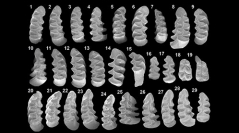

 Comptes Rendus Palevol
15 (6) - Pages 621-634
Comptes Rendus Palevol
15 (6) - Pages 621-634The Sierra de Atapuerca (Burgos, Spain) contains the most comprehensive archaeological and paleontological evidence of human evolution in Europe during the Quaternary. The time scale based on the microfossil content of the sedimentary infillings of the caves of Atapuerca has been used to attribute relative ages to the various paleontological and archaeological levels and correlate amongst the different sites. Microfossils are particularly significant as they are the dominant constituents of the caves from the Pleistocene to the Holocene of the Sierra de Atapuerca. The microfossils of the Atapuerca sites are mainly composed of isolated bones and teeth from small vertebrates, and the hard tissue of the vertebrate skeleton can be taxonomically classified. In revisiting the distribution and the classification of the small-mammal taxa along five of the main stratigraphic sequences from Atapuerca (Sima del Elefante, Gran Dolina, Galería-Zarpazos, Sima de los Huesos, and Portalón), we apply a new method, the “Unitary Associations” method, in order to refine the existing biozones, adding five new Faunal Units, and interpret their relative age. Finally, we correlate Atapuerca with other Pleistocene sites of Europe.
Quaternary, Biostratigraphy, Statistic Analysis, Small Mammals, Ages of Homo , Atapuerca